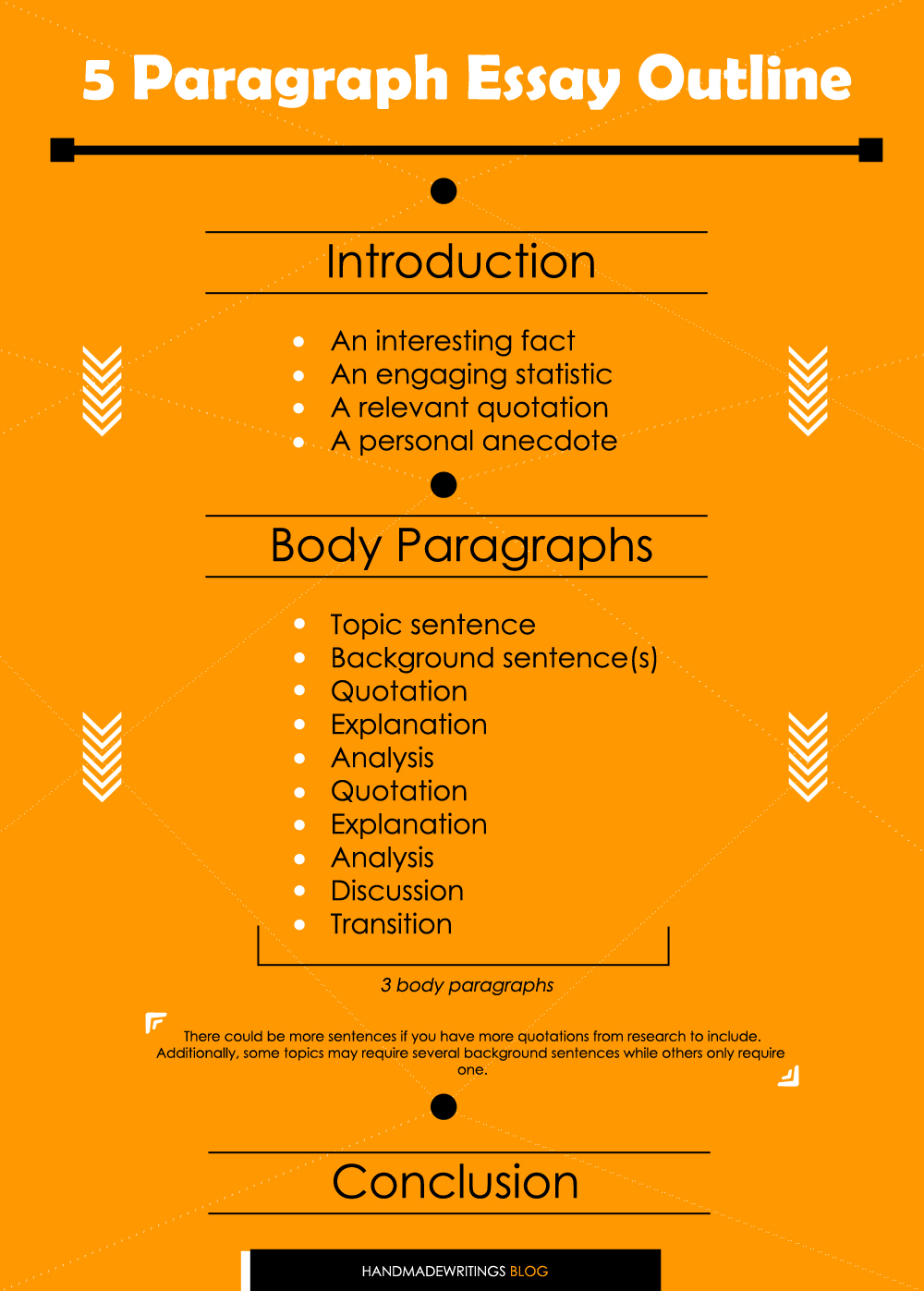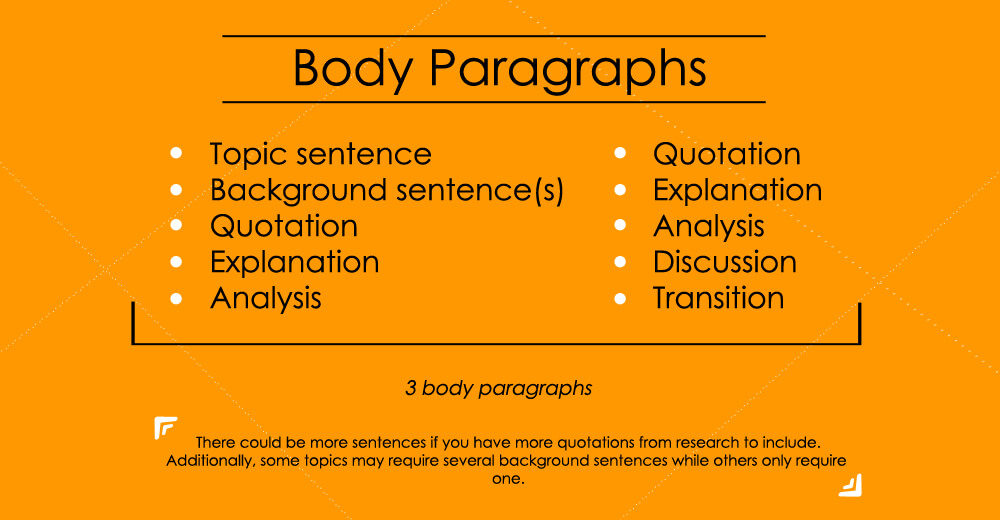What is a Five Paragraph Essay?
Unlike some misleading names, the five-paragraph essay is exactly what it sounds like: an essay that consists solely of five paragraphs. This type of essay is strictly about the structure. That’s what matters much more than the topic or questions to be discussed in the essay. The paragraphs in the essay paragraphs follow a very specific outline.
This kind of essay was separated from all other types with a sole purpose – teaching students about the concept of the essay by practicing it’s most basic structure variant. Even though any kind of essay can have five paragraph – from a definition essay to story-based narrative essay; five paragraph essay is never limited to the approach. It might look like any other essay, but the structure is the king here.
Meet the Five Paragraph Essay Outline
This type of essay contains three distinctly different kinds of paragraphs including (in order):
- Introduction paragraph
- Three body paragraphs
- Conclusion paragraph
While all three types of paragraphs follow traditional grammar and syntax conventions, what goes into each paragraph varies based on its purpose.
Let’s take a look at what makes each of these paragraphs unique:

Introduction
The introduction paragraph should have three key parts: an attention getter, background information, and a thesis statement. These elements should appear in this order; the thesis statement typically appears as the last sentence in the introduction because it acts as a transition to the body paragraphs which each work to support the argument outlined within the thesis. Let’s say that the topic of your five paragraph essay is the best type of pet to own. After doing some research, you decide to write about cats. The attention getter sentence should capture the audience’s attention and make them want to read more about cats. Attention getter sentences often fall into one of four categories:
- An interesting fact
- An engaging statistic
- A relevant quotation
- A personal anecdote
- we
- sd
It’s important to note that a personal anecdote or story from your own life may not be appropriate for all types of essays — especially if an instructor has noted that no personal pronouns be used in the paper.
Related post: How to write an Essay introduction
After gaining the audience’s interest, the next few sentences, anywhere from 3 to 10 sentences, depending upon the essay, should be about background information. Such information may define specific vocabulary or generally provide background information relevant to the topic.
In a five-paragraph essay about cats, relevant background information could include when cats became domesticated, how many breeds of cats are available today, and where individuals can find cats as pets.
Finally, the last part of the introduction paragraph should be the thesis statement. A well-written thesis statement should include an argument and a roadmap on how to prove it.
In this case, a simple yet effective thesis statement could be: “Cats make the best pets because they are intelligent, friendly, and sociable.” The first part, “cats make the best pets” is the argument while the second part, “intelligent, friendly, and sociable” is the roadmap. This is called a roadmap because it outlines the ideas that will guide the paper in the body paragraphs.
According to this thesis statement, there will be a body paragraph that provides evidence that cats are intelligent, another proving that cats are friendly, and a third proving that cats are sociable.
Stuck on writing your outline? Our essay writer will help You!
Body Paragraphs
A typical body paragraph is anywhere from six to twenty sentences; the length of a body paragraph depends upon the amount of research, analysis, and discussion needed in each paragraph to support the argument set forth in the thesis statement. Typically, a body paragraph will follow an organization such as this:
- Topic sentence
- Background sentence(s)
- Quotation
- Explanation
- Analysis
- Quotation
- Explanation
- Analysis
- Discussion
- Transition
There could be more sentences if you have more quotations from research to include. Additionally, some topics may require several background sentences while others only require one.

Remember: value your time and your teacher’s time; skip writing sentences to pad the length of your paper and ask yourself if each sentence contributes to proving the argument outlined within the thesis. If the sentence doesn’t, get rid of it!
Conclusion
The conclusion paragraph should be the final paragraph in the paper. It is often the shortest paragraph. Its purpose is to review the main points and prove to the audience that the writer has successfully argued his or her point. A conclusion paragraph should never introduce any new information. Most teachers prefer students to skip obvious phrases such as “In conclusion” or “Before ending” because these statements are understood by the reader.
Related post: Cause and Effect essay outline
Following the conclusion paragraph, you will likely need to create a “Works Cited” and/or a “Bibliography” page if you included any type of research within the five paragraph essay outline. After each quotation or paraphrase in the essay should be a parenthetical citation, and each parenthetical citation should be referenced in the Works Cited and/or Bibliography page. Your teacher or professor should clearly communicate their preference; a Works Cited page exists as a reference for all the works quoted in the essay whereas the Bibliography page lists every source you consulted during the research process.

Tips and Tricks
If writing isn’t one of your favorite requirements of academic life, check out these 10 tips and tricks to navigate creating a five paragraph essay smoothly:
- Begin early
- Make an appointment with the teacher to discuss your ideas/progress and get feedback
- Take good notes, and cite the sources as you go
- Create a sentence outline before the draft
- Edit the essay twice: once for content, once for grammar
- Get at least one other person to provide constructive criticism
- Make an appointment at the Writing Center if your campus has one
- Hire a professional editing service to catch pesky grammar errors
- Review the final essay against any provided rubric item by item
- Check the paper’s formatting for spacing, margins, and headers/footers
Writing assignments are never sprints, but they don’t have to be marathons either — try to find a happy medium!








